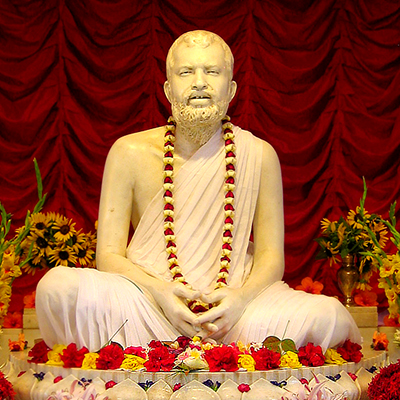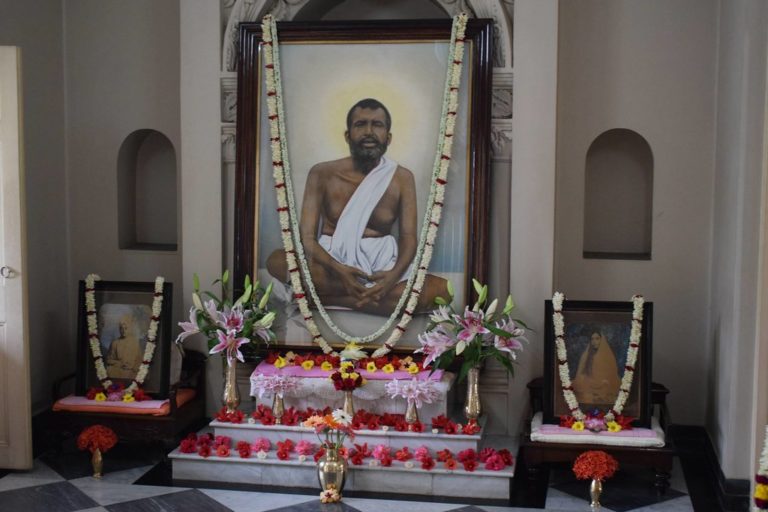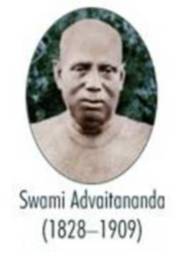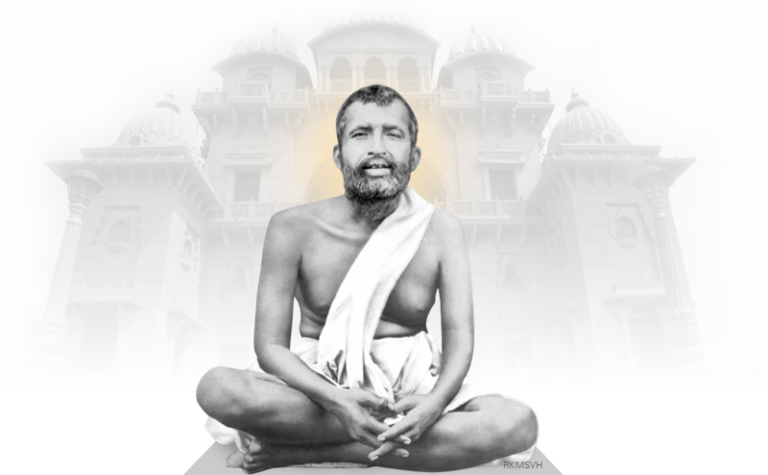I am glad that The Vedanta Kesari is bringing out a special issue in December featuring ‘Ideals in Family Life’, as the core subject, in which my article is on ‘Sri Ramakrishna: A Unique Husband’.
The very subject title seems intriguing because Sri Ramakrishna is considered the great spiritual teacher who advocated renunciation of ‘woman and gold’ again and again to his aspirant disciples.
In the grand hagiographic record of his teachings called The Gospel of Sri Ramakrishna, we see him talking again and again about renunciation of ‘woman and gold’. Then how can he be called a ‘good husband’ even, leave alone a ‘unique husband’? But we will not be so surprised when we learn that he used the terms ‘woman’ and ‘gold’ to mean ‘lust’ and ‘wealth’ or in general, gross and subtle enjoyments of body and mind.
Sri Ramakrishna himself said about his marriage, ‘Just to have gone through the stage called ‘Grihasthashram’, I had to marry.’ Later on, he had to teach by example to the householder disciples that marriage was no bar for God-realization. He thus married in his twenty-third year a five-year old girl (Saradamani), and the next twenty-seven years lived with her a holy life in which their relationship was that of a divine teacher and an ideal disciple. This reminds us of the divine spiritual couple, Yajnavalkya and Maitreyi of the Brihadaranyaka Upanishad. Sri Ramakrishna and his wife both voluntarily gave up all desires of worldly life and preferred to live continually in the infinite bliss of God-realization, sharing their joy with one and all irrespective of barriers like caste, creed, race, religion, and gender.
For example, Sri Ramakrishna once asked Sarada, ‘Have you come to drag me to the worldly life?’, to which she instantly replied, ‘Why should I? I have come to help you in the mission of your life.’
Sarada knew that Sri Ramakrishna’s life’s mission was to teach mankind the pure religion of the Vedas which is Self-realization or God realization. This was to be through renunciation of all carnal desires and through intense yearning for God realization. Thus knowing well that her role would be as a nun in his spiritual mission, Sarada replied ‘I have come to help you in your mission.’
Though for all superficial observation, Sri Ramakrishna’s life with her was that of a husband, in reality he was her protector, spiritual guide, teacher, and trainer of social, and moral traditions. He groomed her to be a world spiritual teacher and the mantle bearer of his world mission which was to deliver the message – ‘Man is divine’, ‘God-realization is the goal of human life’, ‘Practice of the synthesis of four Yogas and harmony of religions’, ‘Service to man is verily the worship of God’, and ‘The whole creation is one and has a divine origin.’
To Sri Ramakrishna his wife was his heir to his spiritual mission of spiritualizing human life everywhere. One uniqueness of this great couple was the lack of any physical attachment between them. We read that Sri Ramakrishna himself proposed Sarada as his bride who was a five-year old girl. He started instructing her even when she was just seven years old telling her, ‘If anyone asks you, say that you were married at five and not at seven.’ And again in her fourteenth year he taught her everything about her duties in social life and also her spiritual goal of god realization. Later on, Sarada said about this, ‘I felt as if a pitcher of bliss was kept in my heart since then. I never in my life knew what suffering was.’ In other words, she had got glimpses of the supreme joy of Samadhi or God realization. Gita refers to such a perennial joy saying यस्मिन्स्थितो न दुःखेन गुरुणापि विचाल्यते ‘established in which one is not perturbed even by great pain.’ (Gita. 6:22)
To Sri Ramakrishna his wife was
his heir to his spiritual mission of
spiritualizing human life
everywhere
Sarada once narrated that on one of Sri Ramakrishna’s visits to Kamarpukur when she was 14 years, she was asked to sleep with him by her in-laws. But Sri Ramakrishna went on speaking to her about spiritual things throughout the night! Sri Ramakrishna was merged in divine consciousness and she also experienced equally uplifted divine feelings.
Sri Ramakrishna was an ordained sannyasi of the Dashanami tradition of Puri. He had no external signs of a sannyasi except perhaps the absence of the tuft of hair which was compulsory for a householder. He never wore saffron robes. Most uniquely he kept his wife with him, allowed her to serve him his special food diet and look after the up-keeping of his room, his clothes etc. He also took care of her physical, social and spiritual well-being. Sarada narrated later that he was so kind to her that he never addressed her as ‘thou’ but only as ‘you’. It is common even today for husbands to address their wives only as ‘thou’. She also said, ‘He never hurt me with even a flower.’ He would be worried even if she got slightly physically indisposed. When she came to Dakshineswar for the first time, the special medical aid given to her by the Master was an eye opener to everyone regarding the duty of a husband!
Sri Ramakrishna like a Vedic Rishi helped his wife to attain the height of spiritual illumination as we read in the days of Yajnavalkya and Maitreyi. The garden at Dakshineswar served as an ancient gurukula of Vedic times, at the head of which Sri Ramakrishna presided.
We see the highest achievements in spiritual life attained by both sannyasis and householders (including women) who had their spiritual initiation and rigorous practice under his protective guidance. If Sri Ramakrishna was moulding the minds of his disciples, Sarada was busy smoothening their hard spiritual life with her motherly care.
Sri Ramakrishna never lost any opportunity to direct innocent jokes at her. Once in her presence he asked Gauri-ma, ‘Whom do you love more Gaur-dasi, me or her?’ Gaur-dasi understanding his mood replied that it was the Holy Mother. Holy Mother naturally felt embarrassed. It was an innocent joke that all enjoyed. There were some un-embarrassing jokes also. Once a young man, a distant relative of the Master, was brought by him to the Holy Mother. The Master asked her that she should look at both of them walking towards her from a distance and judge who was brighter in complexion—a strange proposal indeed by a husband to his wife! Holy Mother as a just umpire, declared the young man as the winner!
The Holy mother said that Sri Ramakrishna was protecting her from the least gust of impure thoughts. Once he cautioned her: ‘Don’t be led away by the talks of some villagers of Kamarpukur who have come here. Thosela dies were discussing that the Paramahamsa who lived here did not live a natural householder’s life with his wife. She also narrated how Sri Ramakrishna saw an old lady talking to her and warned her not to be in her company because she had a bad past life.
Sri Ramakrishna gets the credit
for grooming Sarada Devi as an
ideal woman – as an ideal
daughter, sister, wife, nurse,
guide and highest spiritual guru
– all rolled into one.
We read in The Gospel of the Holy Mother that Sri Ramakrishna instructed Holy Mother in Raja Yoga by drawing the six Yoga chakras on a paper. She also narrated how the Master taught her how to massage well by massaging her forehand!
Sri Ramakrishna wanted her motherliness to be known to the inner circle of his devotees. He told them often that Sarada was his Shakti, and without her his mission would not be fulfilled, that she possessed all knowledge — both secular and spiritual, as she was Saraswati herself —, and that she was capable of giving spiritual liberation because she was Sarada, ‘giver of salvation’
Besides, Sri Ramakrishna would consult Sarada on how a particular disciple should be helped. His instructions regarding strict food regime for his disciples was implemented smoothly by Sarada’s discretion and compassion.
In many cases, her ‘No’ was a binding order for Sri Ramakrishna. The Master jokingly said ‘She said “No” and I with all my detachment had to accept it! What do you then think of worldly husbands who are led by the nose by their wives?’
This unique husband continued to guide his wife even from his celestial abode. Sarada Devi narrates how he stopped her from removing her bangles when she became a widow and assured her that he was ever with her. When she also expressed her desire to leave this world and follow him, he told her, ‘No, you have to remain on earth to do many more things’, and showed how she should attach herself to her niece Radhu and keep her mind tied to this world. Thus he made her work for the spiritual upliftment of people all over the world for thirty-four long years. She in her supreme divine glory guided all his disciples including the great Swami Vivekananda with authority as the powerful voice of Sri Ramakrishna himself.
Sri Ramakrishna gets the credit for grooming Sarada Devi as an ideal woman – as an ideal daughter, sister, wife, nurse, guide and highest spiritual guru – all rolled into one. He enabled Sarada to be the guiding force — for a long 34 years (1886-1920) — behind the World Order (The Ramakrishna Order) of sannyasis started by him.
The role of the highest spiritual head of a monastic order that works for both the secular and spiritual good of humanity, was not an ordinary one. Sarada Devi adorned that position which Sri Ramakrishna had bequeathed to her. Her’s was a silent leadership, full of love, compassion and service. Sri Ramakrishna sent one of his own chosen disciples, Yogendra (later Yogananda), for spiritual initiation from her, thus making Sarada Devi the spiritual head of the new Order of sannyasis (the Ramakrishna Order). Sri Sarada Devi accepted thousands of men and women as her disciples, assuring all of them no rebirth! She said, ‘The Master himself had promised that he will come to them all before their end and lead them to liberation.’ Sri Ramakrishna’s unique husbandship can be compared only to the divine couples of the Hindu Puranas: Shiva and Kali , Narayana and Lakshmi, Brahma and Saraswati, Rama and Sita, Krishna and Radha etc., where both are equally endowed with the powers of God, of granting worldly prosperity as well as spiritual liberation. They are inseparable parts of the one Brahman. It is recorded that Sri Ramakrishna appeared in a divine vision to his disciple Swami Vijnanananda and asked him to initiate his disciples not only with his name but also with Sarada Devi’s name, thus showing that without her, liberation was not possible.
He demonstrated before the
modern world how a man can
transform his family and social
life into a spiritual quest
enjoying infinite peace and joy
individually and collectively in
society.
Once Sri Ramakrishna asked Sarada, ‘How many chappatis do you take in the night?’. Sarada was extremely shy and was at a loss as to what to reply. The purpose of the question was to deposit a sum of money in her name, the interest of which would help her in the days after he would have left this world! What extraordinary concern for the wellbeing of his wife! And perhaps nowhere in the spiritual history of this land we find an equal concern for wife by such a spiritual teacher! Later on Sri Ramakrishna taught his householder disciples that it was the duty of the husband to take care of his chaste wife even after his departure from this world.
We also see Sri Ramakrishna providing Sarada enough ornaments as is worn by a housewife. Perhaps he wanted to fulfil his mother’s words to Sarada long ago, ‘My Gadai will give you better ornaments when you grow up.’ He further added that Sarada desired to wear ornaments because she was goddess Saraswati who can never be without such ornaments, and also for the good of humanity.
A great scholar and writer, wrote regarding SriRamakrishna’s uniqueness thus: ‘In the history we see spiritual teachers without marrying and some teachers giving up their wives for the serious pursuit of spiritual life. But Sri Ramakrishna was unique in that he married with his heart’s consent, kept his wife with him all his life and yet became the unparalleled spiritual Master and Teacher. Thus we see the supreme spiritual power that was Sri Ramakrishna, manifesting in innumerable roles of human life as an ideal son, ideal husband, ideal student, ideal Guru and an ideal lover of mankind. In every case he alone was his equal.’ In Bhagavad Gita, Arjuna says about Lord Krishna, न त्वत्समोऽस्त्यभ्यधिकः कुतोऽन्यो लोकत्रयऽपे ्यप्रतिमप्रभाव, ‘There is none equal to you what to speak of anyone higher than you. You are incomparable in your glory’ (Gita, 11:43) Similarly, Sri Ramakrishna was a unique husband that only a person of the highest spiritual caliber as he could be. He demonstrated before the modern world how a man can transform his family life into a spiritual quest leading to the experience of infinite peace and joy.
Source : Vedanta Kesari, December, 2019




